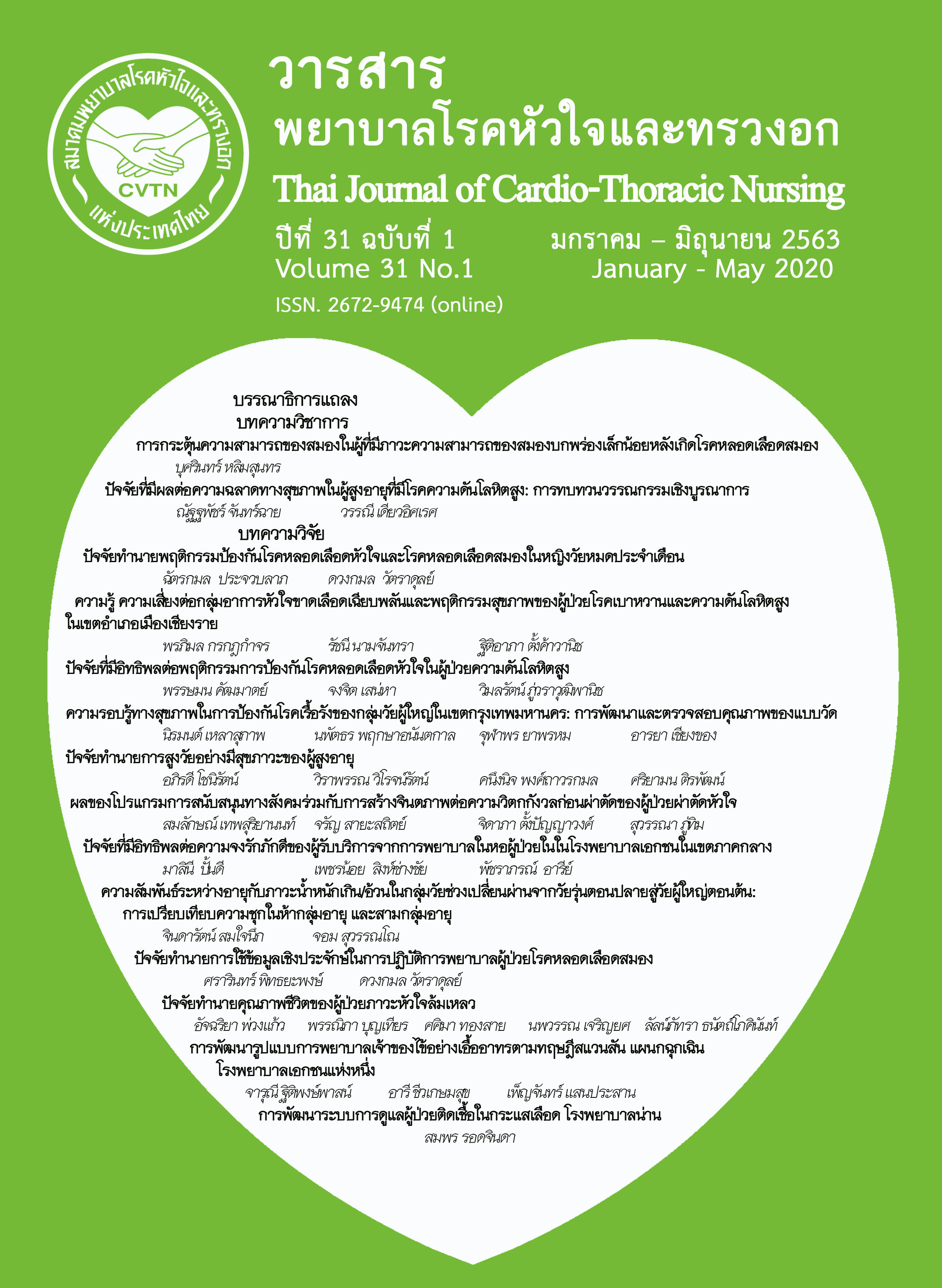The development of a primary nursing model based on Swanson’s caring theory at an emergency department in a private hospital
Keywords:
primary nursing, caring, swanson, emergency department, private hospitalAbstract
This descriptive study aimed to: (1) analyze problems of a nursing care model in an emergency department (ED), (2) develop a primary nursing care model based on Swanson’s Caring Theory, and 3) evaluate an appropriateness of the developed primary nursing model. The key informants comprised 16 nurses working at an emergency department in a private hospital. They were consisted of eight professional nurses, one nurse manager, one supervisor, and six in-charge nurses. Data collection were conducted using focus group discussion with open-ended questionnaires, and an appraisal form of model appropriateness. Data were analyzed by content analysis and calculated the suitability score.
The results of this study were as follows. 1) The problems of ED were divided into three categories. (1) the structure dimension demonstrated, inappropriate ratio between nurse and patient from time to time, unsystematic assignment unless nurses’ competencies consideration, nurses’ roles did not facilitate continuity of care along with nursing process and lack of systematic and proper communication system and patient bed placement. (2)The system of care illustrated lack of continuity of care irrelevant to nursing process and incomplete holistic care. (3) The outcome showed dissatisfaction of both patients and nurses, and incidences of care errors. 2) The developed primary nursing model constructed from resolving emerging problems and integrating with three concepts of primary nursing system, Swanson’s caring model, and Donabedian’s quality of care evaluation model. The model’s structure and process dimensions emphasized on continuity and holistic approach from admission until discharge with systematic communication, while the outcome measured both patient and nurses’ satisfaction along with incidence reports. Finally, 3) the developed primary nursing model was appropriate for adoption with 92.84%.
This study suggests that this model of care should be applied in an emergency department to improve the process of continuing nursing care and to evaluate the quality and effectiveness of care
References
2. Farmer BM, Patient Safety in the Emergency Department. J Emerg Med. 2016; 48(9):396-404.
3. Rogers RW. Implementing relationship based care in an emergency department [Thesis of Master of Nursing Science ]. United States: WaldenUniversity; 2015.
4. Cherry B, Jacob SR. Contemporary nursing: Issues, trends, & management 7th Edition. St. Louis: Elsevier Health Sciences; 2016.
5. Wiman E, Wikblad K. Caring and uncaring encounters in nursing in an emergency department J. Clin. Nurs. 2004;13(4): 422-29.
6. Ramsey Z, Palter JS, Hardwick J, Moskoff J, Christian EL, Bailitz J. Decreased nursing staffing adversely affects emergency department throughput metrics. West J Emerg Med. 2018;19(3): 496–500.
7. Marram GD, Barrett MW, Bevis EO. Primary nursing: a model for individualized care. St. Louis: Mosby; 1979.
8. Swanson KM. What is know about caring in nursing science : a literacy metaanalysis., handbook of clinical nursing research. California:Thousand oaks;1999.
9. Donabedian A. Evaluating the quality of medical care. Milbank Q. 2005; 83(4):691–729.
10. Banchongkien S. Effects of the use of primary nursing system model that integrates watson's nursing theory towards holistic nursing behaviors percieved by patients and professional nurses in emergency care unit. [Thesis of Master of Nursing Science]. Nontaburi: Sukhothai Thammathirat Open University; 2006. (in Thai).
11. Butsaban O.The Development of primary nursing system at surgery department at the tertiary level hospital in Ratchaburi province. [Thesis of Master of Nursing Science]. Nakhon Pathom: Chriatian University; 2014. (in Thai).
12. Janma Y. Development of a primary nursing model in pediatric intensive care unit, nakornping hospital, Chiang Mai province. [Thesis of Master of Nursing Science]. Chiang Mai: Chiang Mai University; 2012. (in Thai).
13. Jobkolsuk P. Effect of the use of primary nursing model that integrates Swanson’s caring theory on crisis event as perceived by primigravida women in the stage of labour. [Thesis of Master of Nursing Science]. Bangkok: Saint Louis College; 2009. (in Thai).
14. Morgan DL. Focus groups as qualitative research 2 nd edition. United States of America;1996.
15. Rungthanakiat P. The development of a preceptor model for new graduate nurses at Surin hospital Surin province. [Thesis of Master of Nursing Science]. Nontaburi: Sukhothai Thammathirat Open University; 2012. (in Thai).
16. Department of Medical Services. Appraisal of guideline for research & evaluation II; AGREE II. Nonthaburi: Department of Medical Services; 2013. (in Thai).
17. Korhonen A, Kangasniemi M. It's time for updating primary nursing in pediatric oncology care: qualitative study highlighting the perceptions of nurses, physicians and parents. Eur J Oncol Nurs. 2013;17(6):732-38.
18. Danulada J . Standard of accident and emergency nursing services: standard of care in hospitals. Nontaburi: The War Veterans Organization of Thailand; 2008. (in Thai).
19. Keeves JP. Educational research, methodology and measurement: an international handbook. United States of America: Elsevier Science & Technology Books; 1988.
20. Phengsawat W. Model development in research. Rajabhat Sakon Nakhon University Journal. 2010;2(4):1-16. (in Thai).
Downloads
Published
How to Cite
Issue
Section
License
บทความนี้ยังไม่เคยตีพิมพ์หรืออยู่ในระหว่างส่งไปตีพิมพ์ในวารสารอื่น ๆ มาก่อน และกองบรรณาธิการขอสงวนสิทธิ์ในการตรวจทาน และแก้ไขต้นฉบับตามเกณฑ์ของวารสาร ในกรณีที่เรื่องของท่านได้ได้รับการตีพิมพ์ในวารสารฉบับนี้ถือว่าเป็น ลิขสิทธิ์ของวารสารพยาบาลโรคหัวใจและทรวงอก






